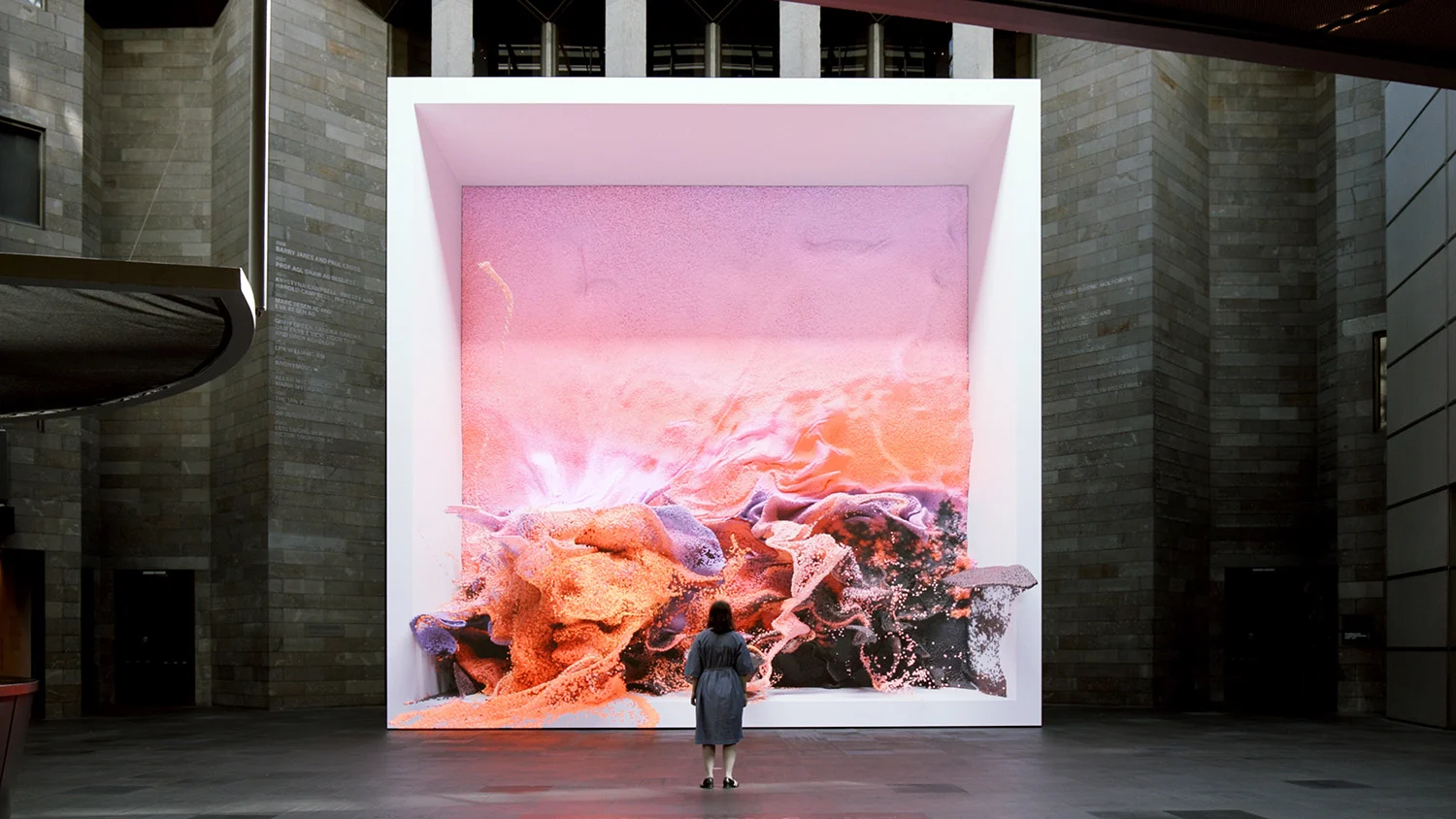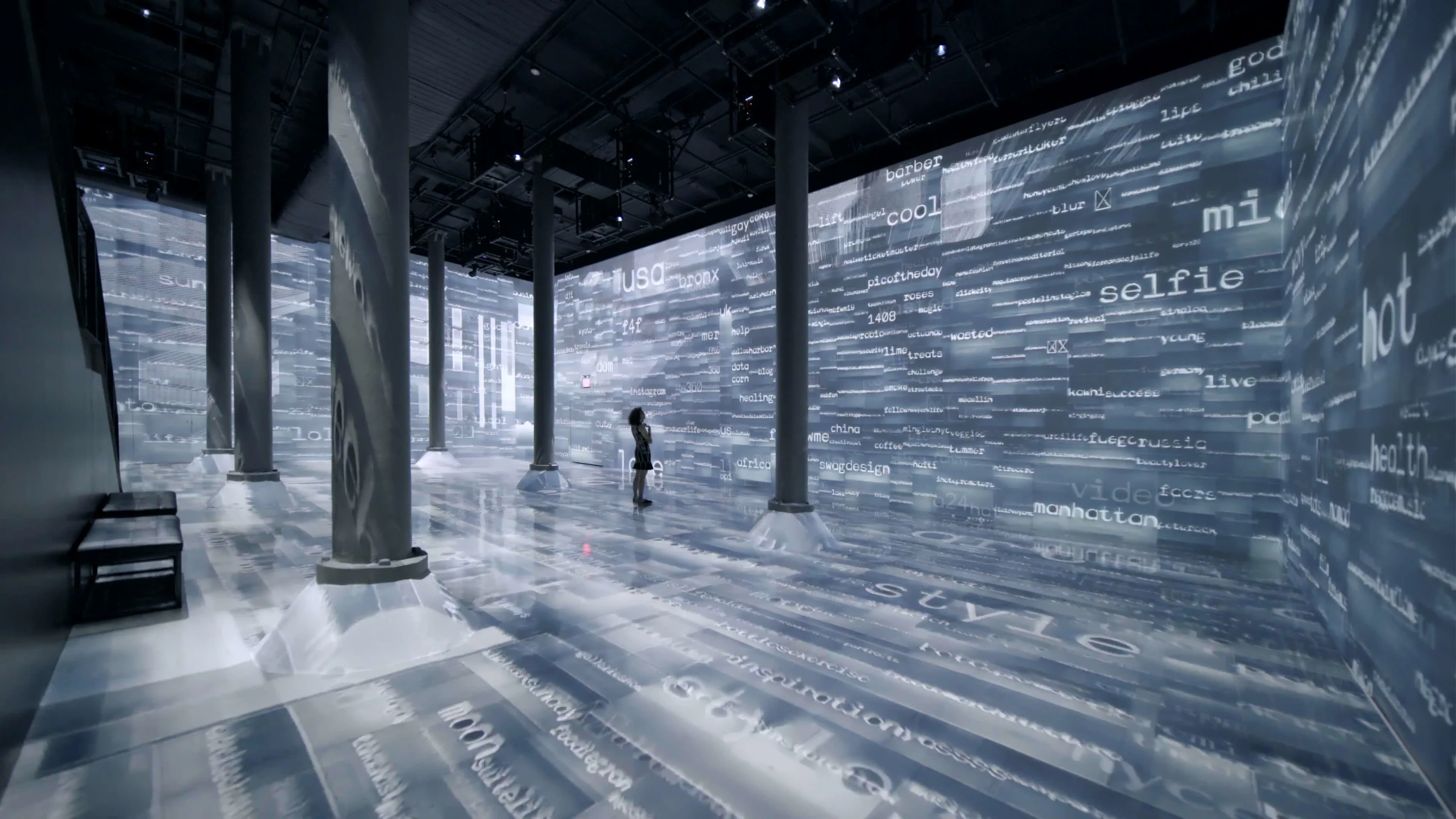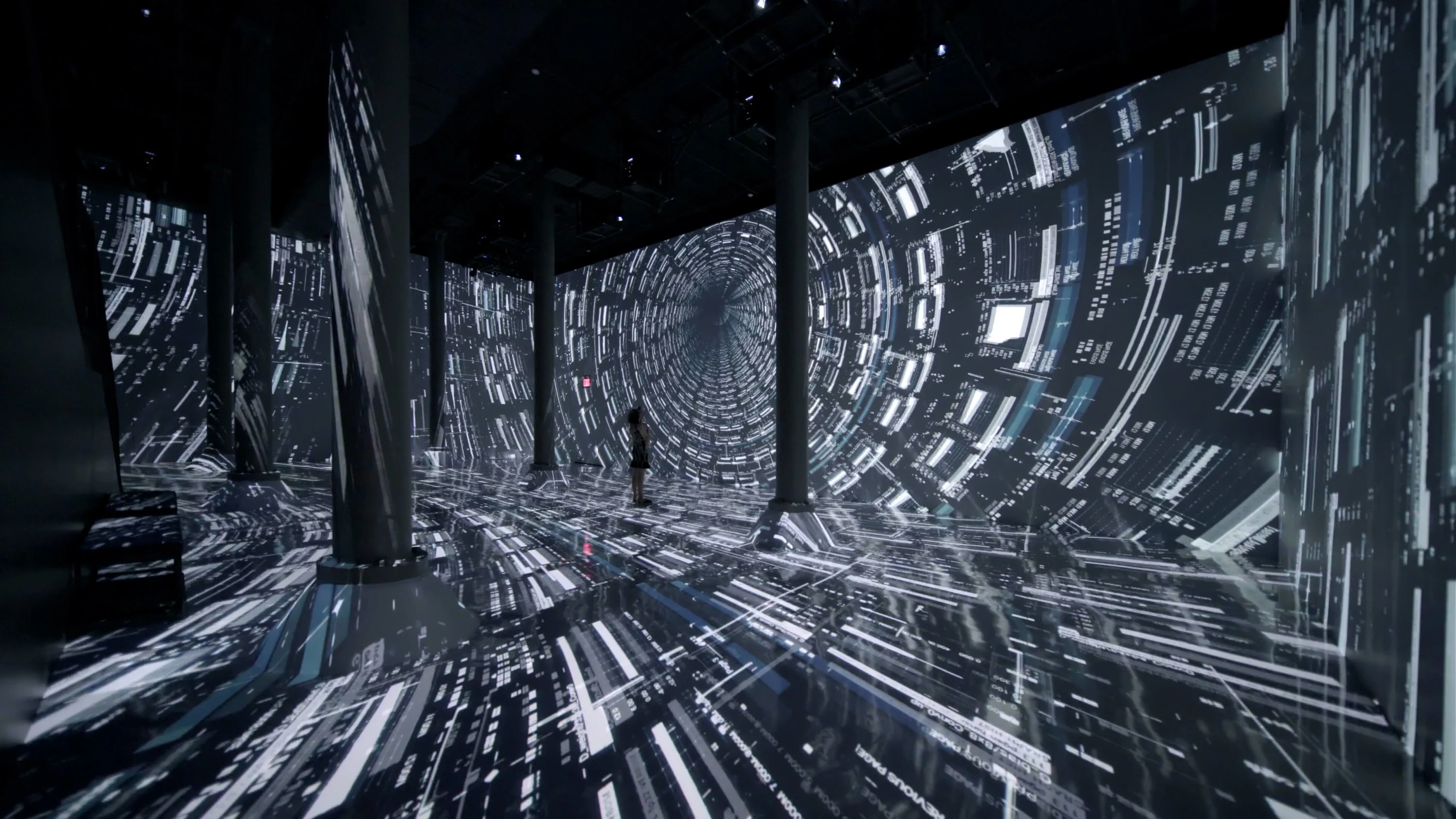
Refik Anadol’s public artworks are dizzying meshes of color and movement. Often entirely built on huge collections of researched data and imagery, his latest projects aim to answer questions about the future, and how our relationship with machines and artificial intelligence fits into it. Here, he tells Sophie Haigney how he uses data to go beyond what our individual brains could ever do and visualize concepts that are often hard to imagine.
A misty forest dissolves instantaneously into rolling hills, which then stretch into mountains. A sunrise becomes a sunset and the weather seems to be moving rapidly across the sky. Really, though, we’re watching whole landscapes changing and morphing into each other seamlessly: mountains becoming wetlands and opening into canyons and ravines. It’s hard to even pinpoint one single landscape amidst the constancy of change.
This is artist Refik Anadol’s Quantum Memories, one of what he calls his “data sculptures.” Like most of his artworks, this one began with a dataset containing photographs and sound recordings. He drew on publicly available photographs of nature from the internet, including shots of water and clouds, Google Earth images of landscapes from Australia, and photos of our planet taken from the International Space Station. He then used both artificial intelligence algorithms and quantum computing to process these images; the algorithms learn patterns from the images and generate new ones, thus creating a dynamic, constantly shifting virtual landscape based on millions of real ones.
The resulting artwork is almost operatic in its arc and scale. At moments it resembles a time-lapse photograph – one which appears to illustrate the whole sweep of geological time – as the features of the world shift and settle into new configurations. At other moments, Quantum Memories is more abstract: swirls of color and patterns appear, representing a nature that appears fantastical.


I’m interested in asking about our collective memories as humanity, of nature, of space.
Refik, who is based in Los Angeles, is something of a renaissance man. He completed a residency at Google’s Artists and Machine Intelligence Program, where he first started using machine learning algorithms in his work. He has a deep interest in everything from the Light and Space Movement to physics to the latest developments in neuroscience research. He started his studio in 2014 and it’s grown to include 14 artists, architects, data scientists and researchers, part of the broader movement by tech-focused artists away from an individualistic approach and toward a studio model for creating immersive work.
Many of Refik’s large-scale projects are made in public spaces, and he’s had installations in places as wide-ranging as the Los Angeles Philharmonic, the LINQ Hotel in Las Vegas, and this year’s Venice Architecture Biennale, where he built a 3D data sculpture that envisioned the architecture of the human brain.
Refik is particularly interested in exploring and pushing the boundaries of what’s possible with technology in artwork. He collaborated with Google’s Quantum AI team on Quantum Memories, and he believes it was the first public artwork to combine artificial intelligence and quantum computing. He began using AI tools in his work as early as 2016.
Almost all of his projects employ massive amounts of data, something he feels can take us further, in many ways, than our own individual minds; he refers to some of his artworks as “data paintings” and “data sculptures.” “Data can become a pigment,” Refik says. “Data can become a materialization of imagination.”

Indeed, one of the most laborious parts of his studio’s process is gathering and sifting through this data. “Collecting and curating data is a very important part,” Refik says. “We spend a very significant amount of time curating and cleaning data.” They use publicly available datasets and other large corpuses of photographs and sound. In the end, no one person’s images are ever shown; everything that appears in Refik’s artworks is ultimately generated by a machine, as an interpretation of the underlying data. The images are scrubbed before machines are trained on them and a special algorithm is used to remove any photographs with people in them, for privacy reasons.
This wealth of material helps Refik approach a concept of collectivity that is central to his work. He believes that machine learning algorithms can process the material to produce something like a collective memory or dream. In the case of Quantum Memories, the result was a collective memory of nature, but nature seen from all vantage points, rather than a single human eye. “I’m not interested in anything personal, in the egocentric expectations,” Refik says. “I’m interested in asking about our collective memories as humanity, of nature, of space, of urban environments.”



What inspires me in my practice is what I sometimes call remembering the future.
Many of his works attempt to answer versions of this question, asking: What would it be like for a machine to dream? Or to have memories? In another work, Machine Memoirs, the result of a collaboration with NASA’s Jet Propulsion Laboratory that began in 2018, Refik says he wondered, “Can a telescope dream? What would the Hubble telescope’s dreams be like?” He used photographs taken by NASA satellites and spacecraft to generate a speculative exploration of space. The result was appropriately otherworldly. Colors melted into each other in configurations that looked at once abstract and realistic. It was, after all, a dream of outer space, a place that almost all of us have only seen in photographs and in our imaginations.
“I think data is a form of memory, and I’m very profoundly asking myself and the team, how can we reconstruct it?” Refik says. These reconstructions, as he and his studio visualize them, are never static. His work is defined by an almost compulsive, occasionally hypnotic motion. There is a commonality evident in many of his projects, both formally and conceptually, especially in this constant flux.


But despite this, Refik’s artworks are strikingly different, in ways that are largely dependent on the data he’s chosen for each work. Whereas Quantum Memories has a placid, almost pastoral quality, and Machine Memoirs has a trippy, dreamlike feel, his work Machine Hallucination, which was featured in the Manhattan space ARTECHOUSE in 2019, is something else altogether. Machine Hallucinations was based on hundreds of millions of images of New York City; and it pulsated with the wild, hectic energy of an urban environment. It was almost dizzying, the sense of a city fractured and then pieced together into a cityscape that was vast and totalizing and constantly moving. It was a rich, immersive envelope of motion and sound, one that had the quality of a place that was simultaneously real and imagined. It was, in its own way, a futuristic vision.
“What inspires me in my practice is what I sometimes call ‘remembering the future,’” he says. “This act of employing machine learning models to use the present and the past to predict the future.”






